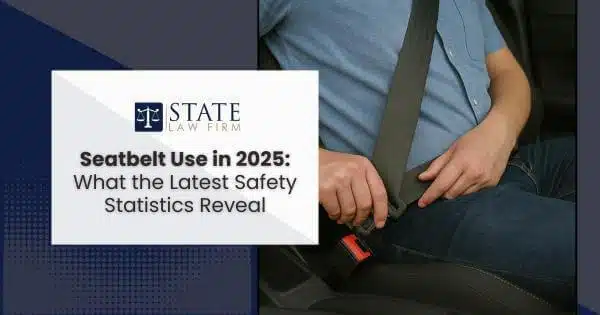Every time you step into a vehicle, one small action can mean the difference between life and death: buckling your seatbelt. Despite decades of public awareness campaigns and legal requirements, seatbelt use continues to be a critical factor in reducing serious injuries and fatalities on the road. The National Highway Traffic Safety Administration reports that seatbelts saved an estimated 14,955 lives in 2017, and countless more in the years since—yet thousands of preventable deaths still occur every year when drivers and passengers fail to buckle up.
As personal injury attorneys here at State Law Firm, we’ve seen firsthand how the simple choice to wear a seatbelt can drastically reduce the severity of injuries after a crash. But seatbelt safety is evolving. In 2025, technology, legislation, and shifting cultural norms are reshaping how Americans use seatbelts—and how effective they are when accidents occur.
In this guide, we’ll explore the latest trends in seatbelt usage across different demographics, how innovative vehicle technology is influencing compliance, and what the future holds for automotive safety. We’ll also take a close look at the real-world consequences of not wearing a seatbelt, drawing on the latest injury and fatality statistics and sharing insights from our experience supporting clients with catastrophic injuries, including those who face the long-term effects of traumatic brain injury.
Whether you’re a driver, a passenger, or simply interested in how policy and technology are shaping road safety, this article is designed to be a practical resource—and a reminder that the small decision to buckle up is one of the most potent ways you can protect yourself and those you love.
The Importance of Seatbelt Use: A Brief Overview
Seatbelts are the single most effective tool to prevent death and serious injury in a car crash. According to the National Highway Traffic Safety Administration, seatbelt use reduces the risk of fatal injury to front-seat occupants by 45% and the risk of moderate to critical injury by 50%.
Beyond personal safety, seatbelt laws are in place across all 50 states (with varying enforcement) to protect everyone on the road. In California, failure to wear a seatbelt can result not just in fines but also increased liability in the event of a collision.
Pro Tip: Always ensure your seatbelt lies flat across your chest and hips. A twisted or improperly positioned belt can cause additional injuries during an accident.
Key Reasons Seatbelt Use Matters:
- Prevents ejection from the vehicle, which is almost always fatal
- Protects the head and spine from severe trauma
- Keeps drivers in position to control the vehicle during emergency maneuvers
When we assist clients after serious accidents, we often see how consistent seatbelt use can mean the difference between walking away and facing lifelong complications. If you’re ever involved in a crash, our Sherman Oaks car accident attorneys are here to help you navigate your options.
Current Trends in Seatbelt Usage Rates Across Different Demographics
Seatbelt usage varies across different age groups, regions, and demographics. Recent data show that:
- Young adults (ages 18–24) have the lowest seatbelt use rates among all age groups.
- Men are less likely to buckle up than women.
- Rural drivers wear seatbelts less consistently than urban drivers.
In 2025, usage rates have improved overall thanks to awareness campaigns and vehicle safety reminders. But gaps remain. For example, a study from the Insurance Institute for Highway Safety indicates rear-seat passengers are still substantially less likely to buckle up, even in vehicles with advanced reminders.
Understanding who is most at risk can inform the development of better policies and public education campaigns. As personal injury lawyers, we also see that insurance companies scrutinize seatbelt use when evaluating claims, making it even more important to prioritize this simple habit.
The Impact of Technology on Seatbelt Effectiveness and Compliance
Modern vehicles are evolving to make seatbelt use nearly automatic. In 2025, many models include:
- Smart seatbelt reminders that escalate alerts if occupants remain unbuckled
- Adaptive restraints that adjust tension based on crash severity
- Seatbelt interlocks that prevent the car from shifting out of park without all belts engaged
These innovations are improving compliance rates, particularly among younger drivers who are accustomed to innovative technology.
Pro Tip: When shopping for a new vehicle, ask about seatbelt interlock systems and pretensioners. They have been proven to reduce injury severity in collisions.
While technology helps, human behavior still plays the most significant role. If you or someone you care about has been hurt in a crash involving seatbelt failure or misuse, our team at State Law Firm can help you understand your legal rights.
State-by-State Analysis: How Legislation Influences Seatbelt Usage Rates
Seatbelt laws vary widely. Some states have primary enforcement, allowing officers to stop drivers solely for not wearing a seatbelt. Others have secondary enforcement, meaning another violation must occur first.
California’s Approach:
- Primary enforcement law
- Fines start at $162 for adults and $490 for children under 16
- Strict child restraint requirements based on age and size
Research consistently shows that primary enforcement states have higher compliance rates. For example, in states with primary laws, usage exceeds 90%, while secondary enforcement states average closer to 80%.
If you’re traveling across state lines, be aware of local regulations. The legal consequences of non-compliance can be significant, especially if an accident occurs and injuries result.
A Look at the Consequences of Not Wearing a Seatbelt: Injury and Fatality Statistics
The numbers are precise: not wearing a seatbelt dramatically increases your chance of dying in a crash. According to the Centers for Disease Control and Prevention, more than half of teens and adults who die in car crashes are unrestrained at the time of the accident.
Common Injuries from Not Wearing a Seatbelt:
- Traumatic brain injuries
- Spinal cord damage
- Internal bleeding
- Complex fractures
Beyond physical consequences, there are legal and financial ramifications. Injury claims can be complicated if you weren’t wearing a seatbelt, and some damages may be reduced.
If you or a loved one has experienced a serious injury due to a collision, whether restrained or not, it’s essential to understand your options. Learn more about how injuries like traumatic brain injuries can affect long-term health here.
The Future of Seatbelt Safety: Predictions and Innovations for 2030 and Beyond
The next decade is likely to bring significant advancements in occupant protection. Here’s what industry experts predict:
- Fully integrated, thoughtful restraint systems that adapt dynamically to crash conditions
- Automated driving technology that reduces crash likelihood but increases the need for robust seatbelts during unexpected maneuvers.s
- Enhanced child safety restraints with improved ease of use and compliance tracking
While vehicle technology evolves, one thing remains constant: the importance of personal responsibility. Buckling up will always be the simplest, most effective way to stay safe.
As a boutique personal injury law firm, we’re passionate about staying informed on the latest safety innovations so we can advocate effectively for our clients. If you ever have questions about how seatbelt use may affect your rights after a crash, our attorneys are here to help you find clarity and move forward confidently.


